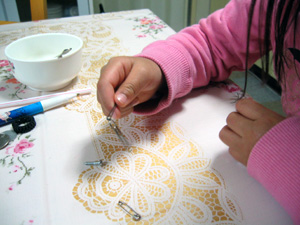While I was bathing Aya one day, out of the blue she asked me, “Nanay, totoo ba yung obake (Are monsters real)?” Obake is pronounced as o-ba-ke, which means “monster” in Japanese. “Syempre naman, hindi totoo yung obake. Panakot lang yun sa mga bata. Nakakita ka na ba ng obake? (Of course, monsters are not real. They’re used only to scare kids. Have you ever seen one?),” was my reply. Aya shook her head.
What does it mean when we say something is real or not? I asked her this time. We have to see something for ourselves to know whether they are real or not, I further explained. For example, am I real? To which Aya replied, “Yes!” Are you real? I asked. Again she said, “Yes!” Eh yung obake? She then answered, “No!”
I pressed further, “Eh si Santa Claus?” Without missing a beat, she gleefully answered, “Totoo!” I couldn’t help but laugh out loud. I let her go at that; the reality of Santa Claus will have to wait until the next bathtime, or next Christmas perhaps. Aya has already told me what she wants Santa Claus to give her this Christmas. She didn’t ask for a new DVD, new clothes, or toys. No. All she wants is a “rake.” Not the toy rake, but a real rake, which she will use in a “hatake” (hatake means field in Japanese). Oh boy. The crazy things they put into your child’s mind at the daycare. Every year the class goes to a kamote (sweet potato) field trip, where they dig up kamoteand each child gets to take home a ration. I’ve never dug any kamote in my life; at four years of age, Aya has experienced doing that at least twice already. No wonder she wants to do farming…hehehe. 🙂
Back to Santa. Well, when I was a kid, I too believed that Santa Claus was for real. I hung up socks at our door every Christmas eve, and my parents dutifully placed goodies in them before I woke up the following morning. And I really thought that those goodies came from him!
When I grew up I eventually learned about the truth, and I really wondered why parents have to make their children believe in the fat, old man delivering presents to good kids every Christmas. And I wondered whether in my time, I would also get into the same adult conspiracy against my kid.
I find myself now in that situation. As much as I would like to tell her that there is no Santa Claus, I found her belief to be so empowering that I feel helpless. I couldn’t find the heart to break it to her – in a way, I wanted her to keep believing simply for the heck of it. Why? Because to believe is to be naive. Because she has a right to believe in something delightful as getting a free present as long as she remained good. Because one day she will grow up and find herself disbelieving and cynical of the good things in life. And most of all, because she’s a kid. She reminded me of those Christmases of long ago when I believed anything and everything.
So for now, for her sake Santa Claus will remain real. But I better find a way to make her change her Christmas wish!
 After a week, I received a similar instant message from my sister-in-law. This time, the message was an invitation to view some photos in some website by clicking the provided link. Since there was no other note included, I suspected that the message was not from her. My suspicion was confirmed when after a few seconds, another message was sent. Hmm, another compromised messenger account, I thought. I sent a message back and advised her to change her messenger password ASAP.
After a week, I received a similar instant message from my sister-in-law. This time, the message was an invitation to view some photos in some website by clicking the provided link. Since there was no other note included, I suspected that the message was not from her. My suspicion was confirmed when after a few seconds, another message was sent. Hmm, another compromised messenger account, I thought. I sent a message back and advised her to change her messenger password ASAP. 













